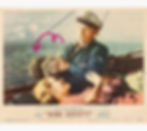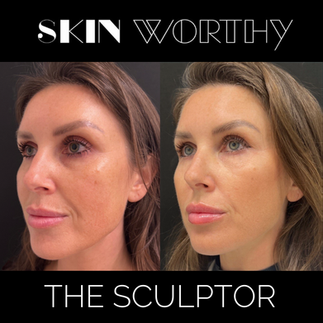Treating An Aging Jawline - Yes Those Jowls Too
- Skin Worthy
- Mar 2, 2024
- 5 min read
Updated: Mar 4, 2024
Aging brings with it many physical changes, but one of the most prominent is loss of definition and contour in our jawlines. While all 5 layers of the face impact the aging process, our jawlines loose their “sharpness” largely due to bone resorption, as well as a loss of volume higher up in the face. While many of us over the age of 35 aren’t looking for a snatched jawline, we would like to restore some definition in it and thankfully there are a variety of non-surgical and non-invasive treatments that can deliver the results we are after.
The Boney Truth About An Aging Jawline

In a 2010 study, a group of plastic surgeons reviewed 120 facial CT scans representing 20 men and 20 women in each of three age groups: 20-36, 41-64, and 65 and older. They found that the angle of the jaw between the horizontal and vertical parts increases with age, causing the jaw to jut forward but at a lower height. The lead researcher noted, “These measurements indicate a significant decline in the jaw’s volume as a person ages and therefore less support of soft tissue of the lower face and neck.
In addition to boney changes to the jaw/mandible, a receding chin is also part of the natural aging process for both men and women, causing slight retrogenia, a condition that occurs when your chin projects slightly backward toward your neck.
Both of these changes to the facial bones directly impacts the structure for all of the layers above. This loss of scaffolding results in less tension on the tissues, resulting in a more saggy and less pronounced appearance. This is known as the concertina effect. A concertina is the small, accordion-like instrument that you may have seen sailors play in old movies and TV shows.

If you envision how the instrument works, you can easily understand the principle. When the concertina is stretched out long, the connection between the two hand pieces gets smooth. When the sailor brings their hands together, though, folds and creases appear and deepen. A similar effect happens with the skin on your face. Initially, your bones and muscles hold your skin taut and smooth. However, as the jaw shrinks and collapses–the skin folds, creating deep wrinkles in many places, such as around your mouth - often referred to as jowls.
The best treatment options to address changes to the bone structure is with robust HA dermal fillers or biostimulators like Radiesse and Sculptra.
Let’s Go Deep (Into Fat Pads)

The deep fat pads on your face actually serve multiple roles. Deep fat pads have a biochemical role by producing energy when needed, they play a functional role by providing a degree of support for the muscles to prevent them from sagging or getting stretched too easily and they play an aesthetic role by projecting and conveying a sense of health - when the fat pads are positioned in the ‘right’ place, have the correct levels of volume, it creates what we perceive as a beautiful and harmonious face.
When looking at the jawline, our treatment focus actually moves up to the mid face fat pads, in particularly the sub-orbiculares oculi fat (SOOF). As these fat pads age, they shrink or waste away in size, but they also descend downwards and cause the lower portions of the face to appear heavier.
To address depletion or descent of fat pad in the mid-face, the most optimal treatment is to again use dermal fillers to restore lost volume and provide support.
Muscle Up
The jawline is an area of the face that has multiple different muscles that impact its movement and appearance.

1. Masseter- located at the angle of the jaw, functionally, this muscle is one of the main four muscles responsible for the action of mastication (chewing), aesthetically it helps to provide structure. As we age, the masseter tends to get larger and bulkier which may create a heavy appearance to lower face and even distract from the boney angular appearance of a jawline
2. Platysma- These muscles are often thought of solely existing in the neck to attach it onto the lower face /jawline. The platysma functions to depress the mandible, pull the bottom lip to the sides and downward, and tense the skin of the lower face and front of the neck. These actions allow a person to make many facial expressions such as being afraid, shocked, and surprised. With age, repetitive motion and other contributing aging layers of the face, strong platysma muscles can cause a pulling downward appearance of the entire lower face.
3. Dao - Located on both sides of the mouth, the depressor anguli oris, is a facial muscle that allows a person to move the corners of their mouth, specifically downward. As we age, it is a contributing factor to the appearance of jowls.
4. Mentalis: The mentalis muscle is the only elevator of the lower lip and the chin, and it provides the major vertical support for the lower lip. As we age, the muscle continues to roll the chin upwards. Since this is also simultaneously happening with the aging bone the appearance of a curled chin can become even more exaggerated.
The best way to address the muscles that impact an aging jawline is of course with the use of neuromodulators - such as Botox, Dysport, Nuceiva or Xeomin.
Superficial in Name but Not in Impact

Within the face, the superficial fat pads compose the layer of fat between the SMAS (Superficial Musculoaponeurotic System) and the skin. The SMAS is a layer of connective tissue and muscle, with fat compartments on top. The superficial fat pads refer to the fat in this layer straight after the skin, which is why they are aesthetically important. Since we are focussing on the lower face, more specifically, the jawline, the primary focus will be on the jowl fat pad and the sub mental fat pad.
Unlike deep fat pads that get smaller with age, superficial fat pads get larger and heavier contributing to the appearance of those dreaded jowls and double chin.
When it comes to treating the jowl and sub mental fat pads, as the goal is to reduce them in size and/or destroy fat cells, the best treatment options include Morpheus8, Evoke, CoolSculpting and Belkyra. Morpheus8 and Evoke both are radio-frequency devices that add heat to the tissues, to target the fat pad and tighten the skin, while CoolSculpting and Belkyra are used to simply destroy unwanted fat cells in the targeted treatment area. By reducing the size of the fat pad, patients are left with a more contoured, and defined separation between face and neck.
By The Skin Of My Chin…
Nowhere on our face is safe from the loss of collagen as we age. As we get older, our skin appears thinner and weaker and tissues appear saggier, especially in the lower face.

Improving skin quality in the lower face can be best treated with our most popular Skinergy combination treatment - The Sculptor (Sculptra, Evoke and M8). Many aesthetic procedures induce a reaction in the skin and thereby stimulate a wound healing response that leads to skin renewal and rejuvenation, but when you double (or in this case triple) down on that process you facilitate a heightened wound healing response and a higher level of improvement than either treatment by itself could provide. Combining these three treatments help tighten the skin, thicken the skin, and achieve a more youthful and overall lifted appearance.
Treating An Aging Jawline
Treating an aging jawline is one of the top concerns for patients, especially when they start to reach peri menopause and menopause. While in many cases, patients may eventually opt for surgical interventions, there are numerous non-surgical and non-invasive options that can address aging of the lower face here in clinic at Skin Worthy. And even better, beginning some of these treatments at an earlier age can help to weaken facial muscles and stimulate collagen, lessening the need for extreme corrective treatments later in life. To learn more about any of the treatments listed above, or to start your own Beauty Evolution, call or text us at 647-350-7546 or click the booking link here.






























